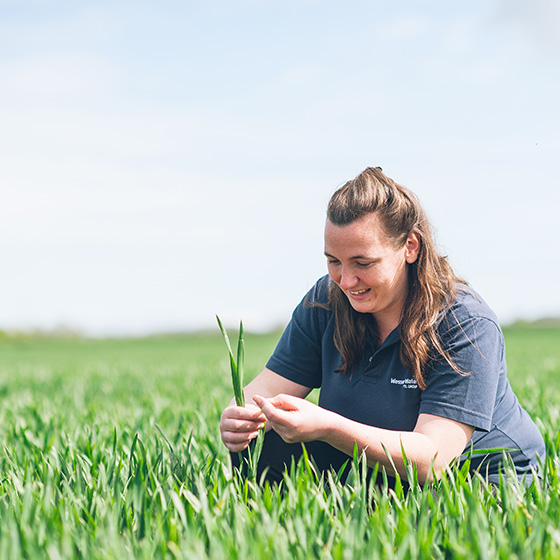- Home
- Our purpose
- Rivers and coastal waters
- Catchment management
- River Stour phosphorus
We are working with farmers to reduce phosphorus (P) runoff from farmyards, tracks and fields by three tonnes per year by 2025.
The scheme and measures are currently being revised ready for our 2026 launch. If you have any queries in the meantime please contact the project team.
Wessex Water is working with farmers in sub-catchments of the River Stour to reduce phosphorus (P) runoff from farmyards, tracks and fields by three tonnes per year by 2025.
This P offsetting initiative forms part of a wider programme of water company investment where P removal is being installed at our water recycling centres (sewage treatment works) across the catchment.
This programme has already resulted in approximately six tonnes less P entering the River Stour each year and by 2025 around a further 190 tonnes will have been removed in this way. Please see examples of this type of investment in the River Stour catchment.
In rural catchments such as the Stour, wastewater treatment is only one source of P to the river, with agriculture being the other main contributor. By working with farmers to reduce P loadings from agriculture, the overall improvement in river water quality will be greater than if only P loadings from wastewater treatment are reduced.
Download our phosphorus reduction scheme flier for a summary of the scheme.
The River Stour Phosphorus Reduction Scheme launched in 2022 and includes a grant scheme offering financial support and advice to farmers for adopting practices that reduce P inputs, prevent soil erosion and buffer watercourses from P pollution.
A range of measures that reduce P loss to water are available for grant funding. Payment rates and measure specifications are as follows:
Expressions of interest are also encouraged in creating runoff ponds, sediment traps and constructed wetlands to treat field runoff and ditch/drain flow, cross-slope hedgerow creation and riparian tree planting.
For enquiries regarding these types of measures, please contact the project team.
Double-funding with other Government or private sector land-management schemes (e.g. Countryside Stewardship Mid-tier, nutrient neutrality, Biodiversity Net Gain and Sustainable Farming Incentive) is not permitted.
Please contact the project team with any queries regarding what is considered double-funding as eligibility for the Wessex Water scheme will depend on what sort of land management changes the other funding scheme requires.
Applications will be scored and funding will be awarded based on a range of criteria, including:
Annual funding limits per farm business for each type of measure may apply:
*Applications for amounts greater than the above limits will be considered in certain situations where the environmental benefits (in terms of reduced P loading to watercourses) can justify the additional expenditure.
In the event of high demand for funding for certain types of measures, further limits may be placed on the amount of funding awarded per farm and funding may be awarded on a first-come-first-served basis.
Please note that the River Stour Phosphorus Reduction Scheme has a fixed annual budget and Wessex Water reserves the right to decline applications.
For more information and advice on the likelihood of your application being successful, please contact the project team at the earliest opportunity to avoid disappointment.
For the priority area, the following measures are available for funding:
For the wider target area, the following measures are available for funding:
If more than 50% of an individual field is within the eligible area it is likely to be eligible for funding.
Please contact the project team with any eligibility queries.
The application process is as follows:
Successful applicants will need to:
Our standard company payment terms are end of the month of invoice plus 30 days. For example, an invoice dated in January will be paid at the end of February.
A member of the project team may arrange an appointment (with reasonable notice) to visit the farm to view the measure.
Please note that you will be required to complete a Wessex Water supplier application form to receive payment.
General terms and conditions will be the same for each project, but project-specific conditions will be as per the specifications above.
You can download this example of a project agreement.
General terms and conditions will be the same for each project, but project-specific conditions will be as per the specifications above.
As part of the project agreement, you will be required to sign a declaration that the fields covered by the agreement have not been the source of a pollution incident in the past five years and that they are being farmed in a way which is compliant with relevant legislation, including Nitrate Vulnerable Zone rules, Farming Rules for Water and SSAFO rules (Storage of Slurry, Silage and Agricultural Fuel Oils):
Please contact the project team if you require assistance in completing the ACT.
For more information on any of the measure options, or to request an advice visit, please email our River Stour Phosphorus Reduction Scheme project team at riverstourphos@wessexwater.co.uk.
You can also contact the project team by post. Any post should be addressed to:
River Stour Phosphorus Reduction Scheme
Wessex Water
The Admiralty
Mill Street
Corfe Mullen
Dorset
BH21 3RQ
Please note, that project specifications and application forms may be subject to changes without prior notice. To ensure the latest version please contact us.
